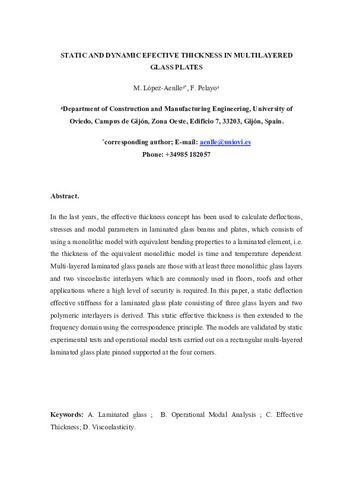Static and dynamic effective thickness in five-layered glass plates
Autor(es) y otros:
Palabra(s) clave:
Laminated glass
Operational modal analysis
Effective thickness
Viscoelasticity
Fecha de publicación:
Editorial:
Elsevier
Versión del editor:
Citación:
Descripción física:
Resumen:
In the last years, the effective thickness concept has been used to calculate deflections, stresses and modal parameters in laminated glass beams and plates, which consists of using a monolithic element with equivalent bending properties to a laminated element, i.e. the thickness of the equivalent monolithic model is time and temperature dependent because the interlayers show a viscoelastic behavior. Multi-layered laminated glass panels are those with at least three monolithic glass layers and two viscoelastic interlayers which are commonly used in floors, roofs and other applications where a high level of security is required. In this paper, a static deflection effective stiffness for a laminated glass plate consisting of three glass layers and two polymeric interlayers is derived. This static effective thickness is then extended to the frequency domain using the correspondence principle. The models are validated by static experimental tests and operational modal tests carried out on a rectangular multi-layered laminated glass plate pinned supported at the four corners
In the last years, the effective thickness concept has been used to calculate deflections, stresses and modal parameters in laminated glass beams and plates, which consists of using a monolithic element with equivalent bending properties to a laminated element, i.e. the thickness of the equivalent monolithic model is time and temperature dependent because the interlayers show a viscoelastic behavior. Multi-layered laminated glass panels are those with at least three monolithic glass layers and two viscoelastic interlayers which are commonly used in floors, roofs and other applications where a high level of security is required. In this paper, a static deflection effective stiffness for a laminated glass plate consisting of three glass layers and two polymeric interlayers is derived. This static effective thickness is then extended to the frequency domain using the correspondence principle. The models are validated by static experimental tests and operational modal tests carried out on a rectangular multi-layered laminated glass plate pinned supported at the four corners
ISSN:
Patrocinado por:
Trabajo apoyado por el Gobierno de España, a través del proyecto BIA2014-53774-R
Colecciones
- Artículos [37549]
- Construcción e Ingeniería de Fabricación [508]
Ficheros en el ítem





